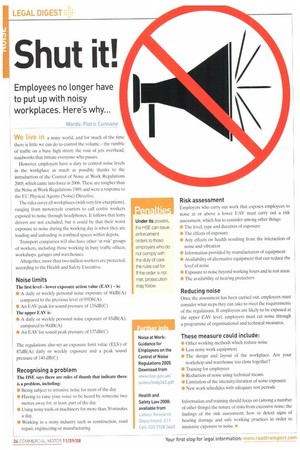Shut it.
Page 34

If you've noticed an error in this article please click here to report it so we can fix it.
Employees no longer have to put up with noisy workplaces. Here's why...
Words: Patric Cunnane We live in a noisy world, and for much of the time there is little we can do to control the volume the rumble of traffic on a busy high street, the roar of jets overhead, roadworks that irritate everyone who passes.
However, employers have a duty to control noise levels in the workplace as much as possible thanks to the introduction of the Control of Noise at Work Regulations 2005, which came into force in 2006. These are tougher than the Noise at Work Regulations 1989, and were a response to the EU Physical Agents (Noise) Directive.
The rules cover all workplaces (with very few exceptions), ranging from motorcycle couriers to call centre workers exposed to noise through headphones. It follows that lorry drivers are not excluded, hut it could be that their worst exposure to noise during the working day is when they are loading and unloading in confined spaces within depots.
Transport companies will also have other 'at risk' groups of workers, including those working in busy traffic offices; workshops. garages and warehouses, Altogether, more than two million workers are protected, according to the Health and Safety Executive.
Noise limits
The first level — lower exposure action value (EAV) — is: • A daily or weekly personal noise exposure of 80dB(A) compared to the previous level of 85Db(A) • An EAV peak for sound pressure of 135dB(C) The upper EAV is: • A daily or weekly personal noise exposure of 85dB(A), compared to 90dB(A) • An EAV for sound peak pressure of 137dB(C) The regulations also set an exposure limit value (ELV) of 87dB(A) daily or weekly exposure and a peak sound pressure of 140 dB(C).
Recognising a problem
The USE says there are rules of thumb that indicate there is a problem, including: • Being subject to intrusive noise for most of the day • Having to raise your voice to be heard by someone two metres away for, at least, part of the day • Using noisy tools or machinery for more than 30 minutes a day.
• Working in a noisy industry such as construction, road repair, engineering or manufacturing
Risk assessment
Employers who carry out work that exposes employees to noise at or above a lower EAV must carry out a risk assessment, which has to consider among other things: • The level, type and duration of exposure • The effects of exposure • Any effects on health resulting from the interaction of noise and vibration • Information provided by manufacturers of equipment • Availability of alternative equipment that can reduce the level of noise • Exposure to noise beyond working hours and in rest areas • The availability of hearing protectors
Reducing noise
Once the assessment has been carried out, employers must consider what steps they can take to meet the requirements of the regulations. If employees are likely to be exposed at the upper EAV level, employers must cut noise through a programme of organisational and technical measures.
These measure could include:
• Other working methods which reduce noise • Less noisy work equipment • The design and layout of the workplace. Are your workshop and warehouse too close together?
• Training for employees • Reduction of noise using technical means • Limitation of the intensity/duration of noise exposure • New work schedules with adequate rest periods Information and training should focus on (among a number of other things) the nature of risks from excessive noise; the findings of the risk assessment; how to detect signs of hearing damage and safe working practices in order to minimise exposure to noise. IN












































































































































































